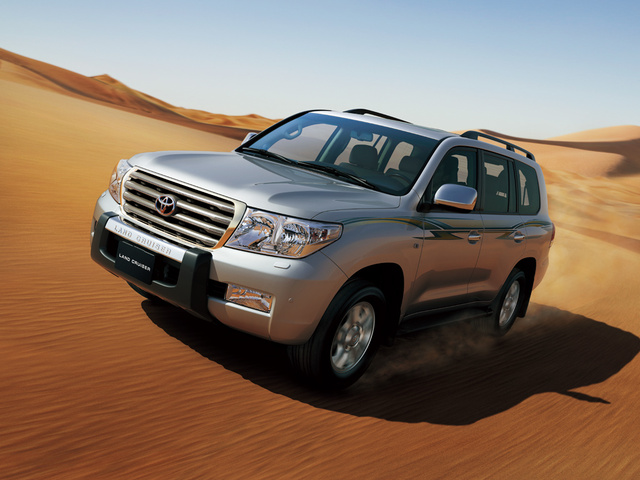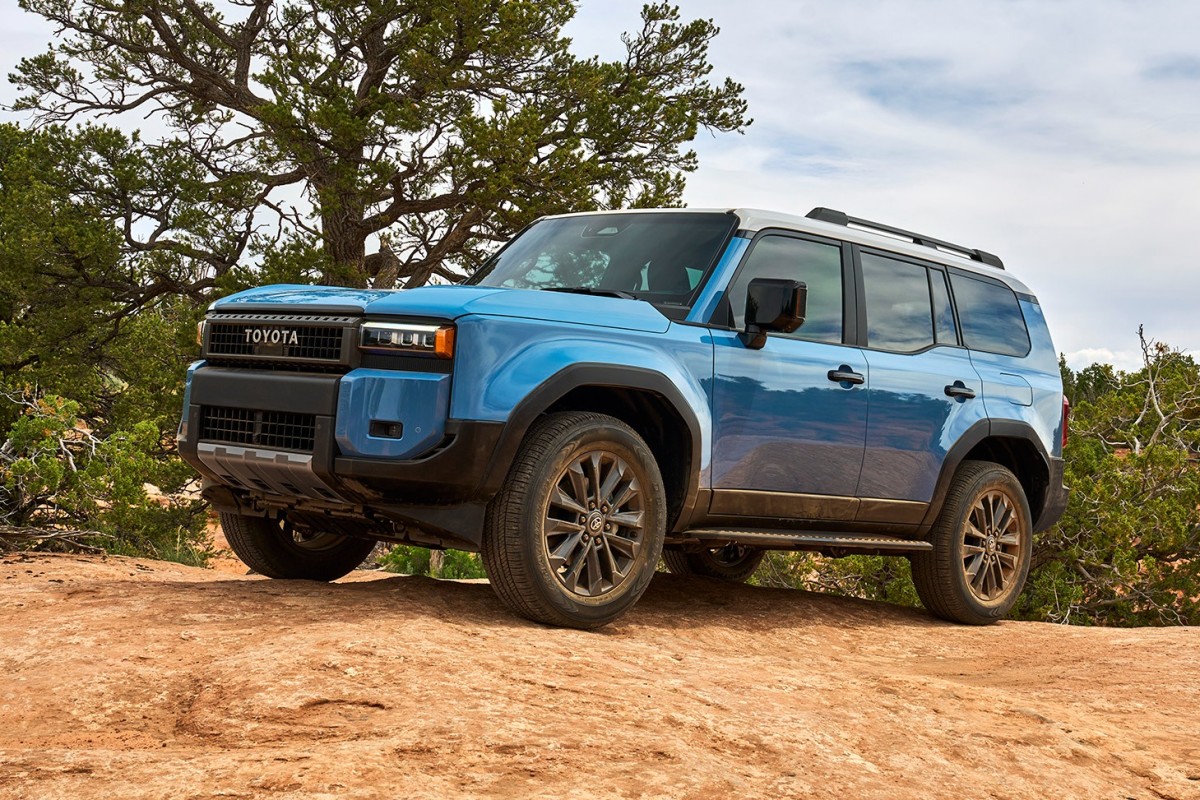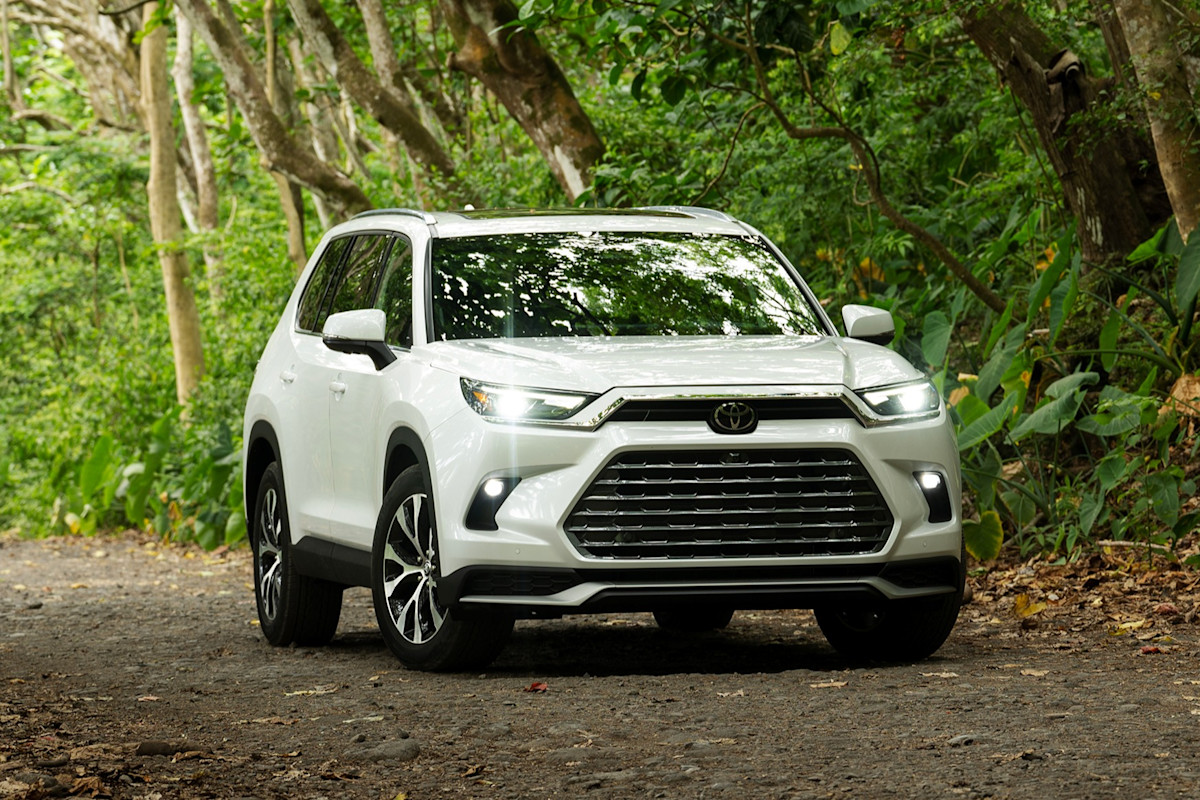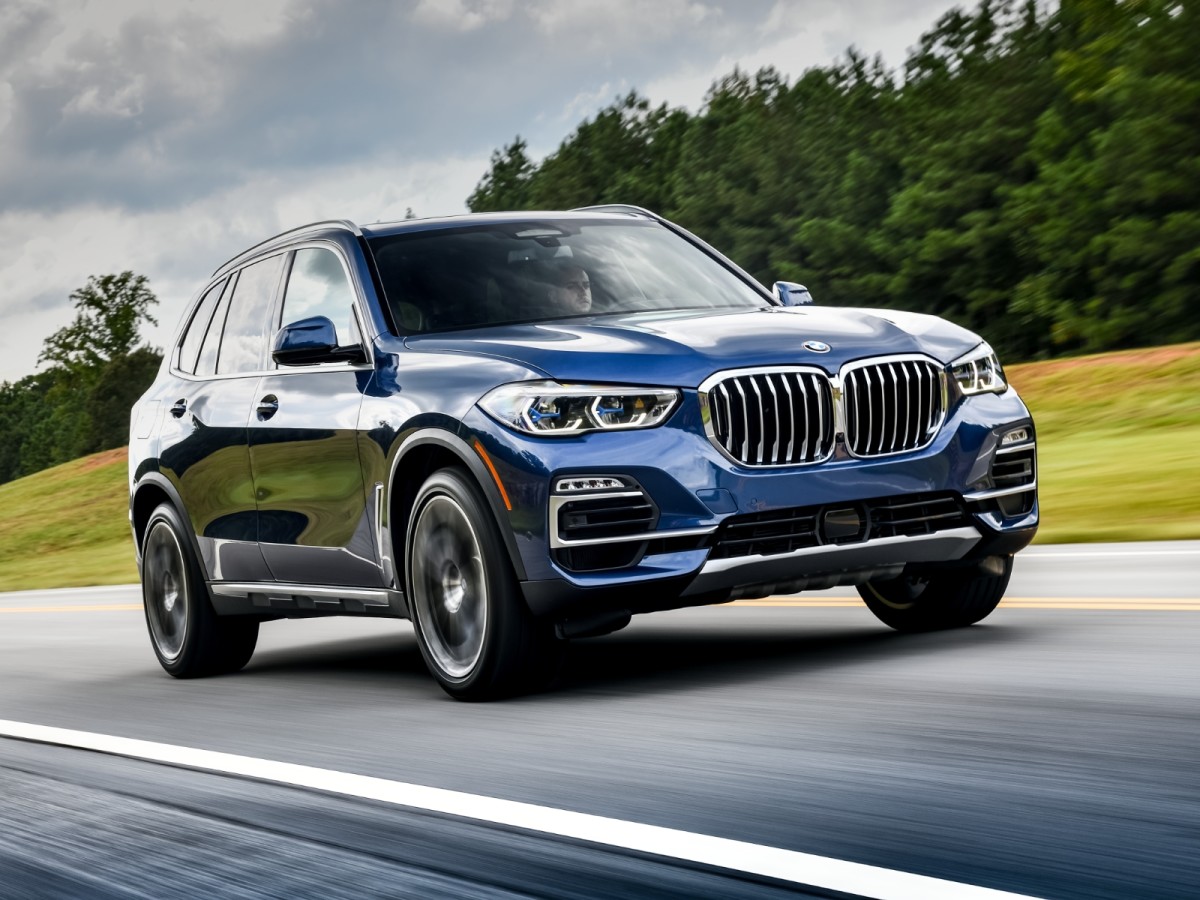The Toyota Land Cruiser is one member of a rare pack of automobiles that has unarguably reached legendary status. It traces its history all the way back to the 1950s, when it was conceived as Japan’s answer to the original military-spec Jeep. In fact, the very first vehicle related to the Land Cruiser was simply called the Toyota Jeep (until that name was trademarked by Willys-Overland in 1943), and built in response to a request from the United States military.
The Land Cruiser grew continuously from its humble originals as basic off-road transportation, and cemented its place in history as the most dependable way to traverse any type of terrain, regardless of how remote the destination.
US-spec Land Cruisers have not always been the same as those sold elsewhere, and several variants have been and still are for sale in countries as varied as Japan, Australia, and the Middle East. For 2024, Toyota released the latest version of the Land Cruiser that’s sold in America. It represented a major departure from the previous version, with half the number of cylinders, the addition of a hybrid drivetrain, and a significantly lower price.
While the 2024 and newer Land Cruiser may be a significantly different vehicle that the one Americans came to know and love, it’s still exceptionally capable off-road, and even if it’s not as luxurious as before, stands out as a premium machine that excels in on-road comfort and modern conveniences. Our buyer’s guide explains all.
Toyota Land Cruiser Buying Guide: Cost, Reliability, and the Best Years to Buy
- Frequently Asked Questions
- Toyota Land Cruiser Pros and Cons
- Toyota Land Cruiser Generations
- Eighth Generation (2024-Present)
- Seventh Generation (2008-2021)
- Sixth Generation (1998-2007)
- Fifth Generation (1991-1997)
- Fourth Generation (1980-1990)
- Third Generation (1998-2007)
- Second Generation (1991-1997)
- First Generation (1980-1990)
Frequently Asked Questions
Which Toyota Land Cruiser years are the best?
The Toyota Land Cruiser has a well-earned reputation for reliability that spans every model and generation sold in the United States. The model we’re calling the eighth generation, which launched for the 2024 model year, is too new and too distinct from past Land Cruisers to recommend based on predicted reliability, but since much of its powertrain and chassis is shared across multiple OEM product lines, we don’t expect it to be particularly troublesome.
The seventh-generation Land Cruiser—sold from 2008 through 2021 in the States and often referred to by enthusiasts as the 200 Series—is known to be extremely reliable. The same can be said for its sixth-generation predecessor or 100 Series Land Cruiser. Both of these Land Cruiser generations used tried-and-true V8 engines, hooked up to transmissions known for reliability and durability.
What are the worst Toyota Land Cruiser years?
There aren’t any Land Cruiser generations with reliability concerns, but that doesn’t mean any used Land Cruiser will be completely free of common problems, and the usual used vehicle rules—a pre-purchase inspection and a thorough test drive—still apply. While the fifth-generation Land Cruiser (1991 and 1997) and the fourth-generation (1980 to 1990) featured inline-six-cylinder engines also known for their reliability, they are getting older and are likely to have accrued a lot of miles. As such, it’s important to make sure any older Land Cruiser has been taken care of and regularly maintained.
Old cars are more susceptible to rust, brittle plastic, and dried-out rubber components that may require replacement, and as legendarily durable as the Land Cruiser may be, it is not immune to the passage of time. Its tough nature means it’s ripe for off-road themed aftermarket modifications, too, so it’s always wise to look out for those and consider how hard the car has been used. What’s more, the older a Land Cruiser is, the less likely it is to have the modern creature comforts today’s buyers expect.
Is a used Toyota Land Cruiser a good deal?
That depends on how much you’re looking to spend. As a used car, the Land Cruiser could qualify as a good deal, even when you recognize it’s not going to be cheap. If a used Toyota Land Cruiser with a reasonable number of miles falls within your allotted budget, then yes, it’s a good deal. The problem is, you’re likely going to need a sizeable budget.
The Land Cruiser has long been one of the most reliable, and therefore among the most desirable, automobiles sold in the United States (and, in fact, globally) and commands premium prices on the used market. That said, a late-model Land Cruiser powered by Toyota’s faultless 5.7-liter V8 engine should offer many years of reliability, and could conceivably outlast newer off-road SUVs from other automakers. And when it’s time to sell, even high-mileage Land Cruisers retain enough value—particularly to off-roaders who like to modify their vehicles—to recoup a good portion of your initial investment.
If you’re shopping for a Land Cruiser from 2024 or 2025, it’s also worth checking out the Lexus GX that was also redesigned for the 2024 model year. The GX 550 features much of the technology and design that makes the new Land Cruiser so capable in the dirt and mud, but features a twin-turbo V6 engine that’s well suited to a rugged and luxurious SUV.
If you’re considering an older Land Cruiser, the previous-generation Lexus GX was similarly rugged (it’s based on an SUV Toyota called the Land Cruiser Prado that’s sold in other markets), featured three rows of seats, and boasted a 4.6-liter V8 engine, full-time four-wheel drive, and excellent reliability. On the used market, the Lexus GX is a relative bargain compared with the larger Lexus LX or Toyota Land Cruiser, though it’s also smaller.
Toyota Land Cruiser Pros and Cons
Pros
- Excellent off-road ability
- Comfortable
- Highly reliable
Cons
- No third row with latest models
- Not much cargo space
- More expensive than competitors
Toyota Land Cruiser Generations
Eighth Generation (2024-Present)
The eighth and current generation of the Toyota Land Cruiser retained its body-on-frame design (as opposed to car-based crossover utility vehicles) but took the storied nameplate in a new direction for the 2024 model year. In place of the previous model’s big, naturally aspirated 5.7-liter V8 engine was a turbocharged four-cylinder boosted by an electric motor. A relatively small 1.87-kWh battery pack juiced the 48-horsepower electric motor, while total output from the hybrid powertrain was 326 horsepower and 465 lb-ft of torque. Those are impressive figures, but in reality, the 2024 and 2025 Land Cruisers felt merely adequately powerful on the road.
The overall experience of the eighth-generation Land Cruiser, known as the Land Cruiser 250 Series, was one of comfort. The ride was well controlled, and while the four-cylinder engine vibrated and could sometimes sound unrefined, it worked well with the eight-speed automatic transmission and full-time four-wheel-drive system to provide confident performance on any surface. In particularly strenuous off-road situations, the two-speed transfer case could be locked into 4Lo, while electronically controlled locking rear and center differentials were standard. A CRAWL Control function acted as a low-speed, off-road cruise control, and offered five selectable speeds. Downhill assist control, also standard, helps the driver navigate downhill off-road sections by limiting speed.
The 2024 Land Cruiser launched with a First Edition model that sat atop the range. Two versions of the eighth-generation Land Cruiser were available for 2025. The base edition was called Land Cruiser 1958, started at $58,195 (including destination) and featured round headlights. It was offered in three colors: black, gray, or white, and with a black cloth interior. Opting for the upmarket Land Cruiser model (the one that lacked the 1958 badge) brought a much fancier color palette, with heritage-inspired blues and browns, plus either leatherette or true leather seats. The $62,965 Land Cruiser had a more modern face, with rectangular headlights on either side of the grille, along with superior off-road equipment, such as a ‘Stabilizer Disconnect Mechanism’ that improved front-axle articulation, and a Multi-Terrain Select system with modes for dirt, sand, mud, rock and deep snow.
Exterior differences between the base 1958 and the regular Land Cruiser included (in addition to the shape of the LED headlamps) 18-inch wheels on the cheaper 1958 versus 20-inch alloy wheels on the pricier model, which also got roof rails and running boards. Inside, where the 1958 had a seven-inch screen in front of the driver, the Land Cruiser featured a much nicer 12.3-inch digital gauge cluster and a Multi-Terrain Monitor with selectable front, side, or rear views of the vehicle’s surroundings at low speeds. Heated and ventilated seats were also standard on the pricier version, and a Premium Package added an upgraded JBL audio system, digital key capability, a power moonroof, a center console cool box, a digital rearview mirror, Qi-compatible wireless charging, leather-trimmed seats with power and memory presets, a head-up display, lane change assist, front cross-traffic alert and traffic jam assist.
Unlike the last few versions of the Land Cruiser in America, the eighth-generation model did not offer a third row of seats. There was plenty of room for the front two occupants, but rear-seat legroom could be a bit tight for tall passengers. Cargo space maxed out at 37.5 cubic feet, and a raised rear cargo floor meant it was a hefty lift to put heavy items in the back.
The new Land Cruiser, with its hybrid powertrain, delivered much better fuel economy than past Land Cruisers. The EPA estimated the eighth-generation Land Cruiser to deliver 22 miles per gallon in the city, 25 mpg on the highway and 23 combined, but it did require premium unleaded fuel. This version of the Land Cruiser could tow up to 6,000 pounds.
Toyota offered a different machine, known as the Land Cruiser 300 Series, in many other markets outside the United States, while a version of the Land Cruiser 300 was sold in American Lexus dealers as the Lexus LX.
Seventh Generation (2008-2021)
The seventh-generation Toyota Land Cruiser was sold between 2008 and 2021 as a bruising off-roader that oozed luxury and off-road capability. Its 5.7-liter V8 engine produced 381hp, 401 lb-ft of torque, and provided effortless power. It also effortlessly drank regular-unleaded gas, with EPA ratings of 13 mpg city, 17 mpg highway and a woeful 14 combined. On the plus side, its towing capacity of between 8,100 and 8,500 pounds meant it was capable of pulling larger campers or boats than the eighth-generation Land Cruiser that replaced it.
The seventh-generation Land Cruiser’s rugged driveline included a full-time four-wheel drive system with a Torsen differential that could automatically send power to the axle with more traction or be locked into a 50:50 power split between the front and rear axles. Multi-terrain select traction assist came standard, and provided settings for rock, loose rock, rock & dirt, and mud & sand. The Land Cruiser’s multi-terrain monitor boasted several camera views and an inclinometer so drivers could more easily monitor the scene outside. Other desirable off-road gear that came standard included a kinetic dynamic suspension system (KDSS) swaybar disconnect, which improved front axle articulation, and a whole suite of skid plates to protect the undercarriage.
This generation came standard with three rows of seats. The rearmost seats could fold down above the floor, but also swing up on either side to offer a taller cargo area and up to 41.4 cubic feet of volume. The sliding second row meant it was possible to put adults in the third row when necessary, though it didn’t offer the cavernous cargo capacity of some full-size SUVs, such as the Chevrolet Suburban or the Cadillac Escalade ESV.
An initial refresh in 2013 added what was then the latest version of Toyota’s infotainment system, and a second update in 2016 brought a dual-screen entertainment system for rear-seat passengers, Bluetooth connectivity, a wireless device charger, blind-spot monitoring, rear cross-traffic alert, pedestrian detection, and automatic emergency braking. An eight-speed automatic transmission replaced the previous six-speed unit, and that dropped towing capacity from 8,500 to 8,100 pounds.
Because it was on sale for a long time, the seventh-generation Land Cruiser’s technology package was severely out of date when it ended production in 2021. Apple CarPlay and Android Auto, which, by then, were staples of large SUVs, were nowhere to be found. A number of buttons, dials and switches on the dashboard and the steering wheel may be a boon for buyers who don’t like to use touchscreens, but those used to more modern systems may baulk at the software on the relatively small nine-inch screen.
The Lexus version of the seventh-generation Land Cruiser was known as the LX 570.
Expect to pay between $40,000 and $50,000 for a low-mileage 2008-2015 Land Cruiser. Around $60,000-$65,000 is to be expected for 2016 and newer Land Cruiser models with less than 100,000 miles on the odometer. Late-model Land Cruiser Heritage Edition models, built by Toyota to mark the end of the SUV’s seventh generation, are the priciest versions, and can approach the $100,000 mark. The Land Cruiser name took a two-year hiatus following the discontinuation of the seventh-generation model at the end of 2021.
Sixth Generation (1998-2007)
The sixth-generation model, known as the Toyota Land Cruiser 100 Series to enthusiasts, was the first with a V8 engine. The 4.7-liter unit produced 230 horsepower and 320 lb-ft of torque, and was initially paired with a four-speed automatic transmission, but gained a more modern five-speed unit in 2003. It also got five more ponies that year, and was bumped to 275hp in 2006 and 265hp in 2007. Engines in the sixth-generation Toyota Land Cruiser use timing belts that must be replaced at regular intervals, often quoted as every nine years or 90,000 miles.
In addition to the modern V8 engine, the sixth-generation Toyota Land Cruiser was fitted with independent front suspension in place of the previous version’s solid front axle. This improved on-road ride and handling, but reduced front-axle articulation. That’s mostly an issue for hardcore off-roading, meaning the compromise was worth it for most buyers.
The sixth-generation Land Cruiser had a maximum towing rating of 6,500 pounds and could seat up to seven across three rows of seats. With all seats in place, there was 20.8 cubic feet of cargo capacity, but with both rear rows folded flat, cargo volume swelled to 90.8 cu-ft.
Lexus sold a version of the sixth-generation Land Cruiser with an upgraded interior and a few additional options as the LX 470.
The sixth-generation Toyota Land Cruiser is common in the United States. Prices for high-mileage examples that are otherwise in solid condition sell in the $15,000-$20,000 range. Lower mileage examples can be found, sometimes with significantly higher price tags.
Fifth Generation (1991-1997)
Toyota released the fifth-generation Land Cruiser in the United States for the 1991 model year. Initially powered by a 4.0-liter inline-six engine that produced 155 horsepower, the Land Cruiser benefited greatly from a new 4.5-liter 1FZ-FE inline-six in 1993 that spun out 212 horsepower and 275 lb-ft of torque, raising towing capacity from 3,500 pounds to 5,000 pounds. Also in 1993, Toyota added front and rear locking differentials to the options sheet.
The fifth-generation, also known as the 80 Series Land Cruiser, was refreshed in 1995, which was also the first year that the automaker sold the Land Cruiser in Lexus dealerships, badged as the LX 450. The Lexus version had an upmarket leather interior with high-quality finishings to go with its increased price.
It’s not uncommon to find a fifth-generation Land Cruiser for sale in America. At this point, these early luxurious Land Cruisers have reached collectible status, with prices that make them unlikely choices for buyers simply looking for a reliable daily driver.
Fourth Generation (1980-1990)
In 1980, Toyota introduced what we’ll refer to as the fourth-generation Land Cruiser. Known to enthusiasts as the 60 Series, this is the version that became truly commonplace in the United States.
At first, the fourth-generation Toyota Land Cruiser used a 4.2-liter inline-six engine, known more for its durability than its power. At 135 horsepower and 210 lb-ft of torque, the Land Cruiser wasn’t fast, but it was reliable. A smaller but more-powerful 4.0-liter inline-six arrived in 1988 with 155 hp and 220 lb-ft, making the Land Cruiser better suited for American highways.
The fourth-generation of the Land Cruiser was the final version sold in the American market to feature solid front and rear axles. A heavy duty four-door 70-Series FJ Land Cruiser entered production in 1984, but was never sold in the United States. It’s still produced in 2025 for several international markets.
Third Generation (1967-1980)
Toyota separated the Land Cruiser lineup into two distinct vehicle segments when it introduced the 55 Series in 1967. There was a heavy duty model, known as the FJ40, with two doors and seriously rugged underpinnings, while the new FJ55 boasted four doors and an extended wheelbase to make it more appropriate for family use.
The first FJ55 models had an inline-six engine with 125 horsepower under the hood. The engine’s low power, coupled with the four-door’s heavy body and chassis, helped the first Land Cruiser station wagon earn the nickname “iron pig”. A 4.2-liter version of the engine with 135hp debuted in 1975.
Second Generation (1960-1983)
The Toyota FJ40 was introduced in 1960 and would go on to become one of the most popular and durable off-road vehicles sold anywhere in the world. It was basic by modern standards, with solid front and rear axles, an un-stressed inline-six engine designed for dependability, and an interior devoid of creature comforts.
Toyota sold the FJ40 in the United States through the 1983 model year, and the ‘J’ in the FJ40’s name still stood for Jeep, though most Americans know the machine as the Land Cruiser. Like the FJ55 four-door, the FJ40 received a 4.2-liter inline-six engine in 1975, and that was the powerplant that would continue to beat under the off-roader’s hood until it ended production.
These FJ models were similar in capability to the American Jeep Wrangler or its CJ-badged predecessors. The Toyota FJ Cruiser, built between 2007 and 2014, was considered a spiritual successor to the classic FJ.
First Generation (1958-1962)
The very first prototype of the SUV that would later be known as the Land Cruiser was developed by Toyota at the request of the United States military. Instead of shipping jeeps all over the world, it was decided that a basic off-roader, built in Japan, would be desirable for use in Asian countries. Although the Americans did not end up commissioning Toyota to build the vehicle, the resulting machine was further refined and offered for sale in Japan. In 1958, the Toyota FJ25 entered the American market.
This first-generation Toyota Land Cruiser used a 3.9-liter inline-six powerplant that was initially designed using an old Chevrolet engine as inspiration.










